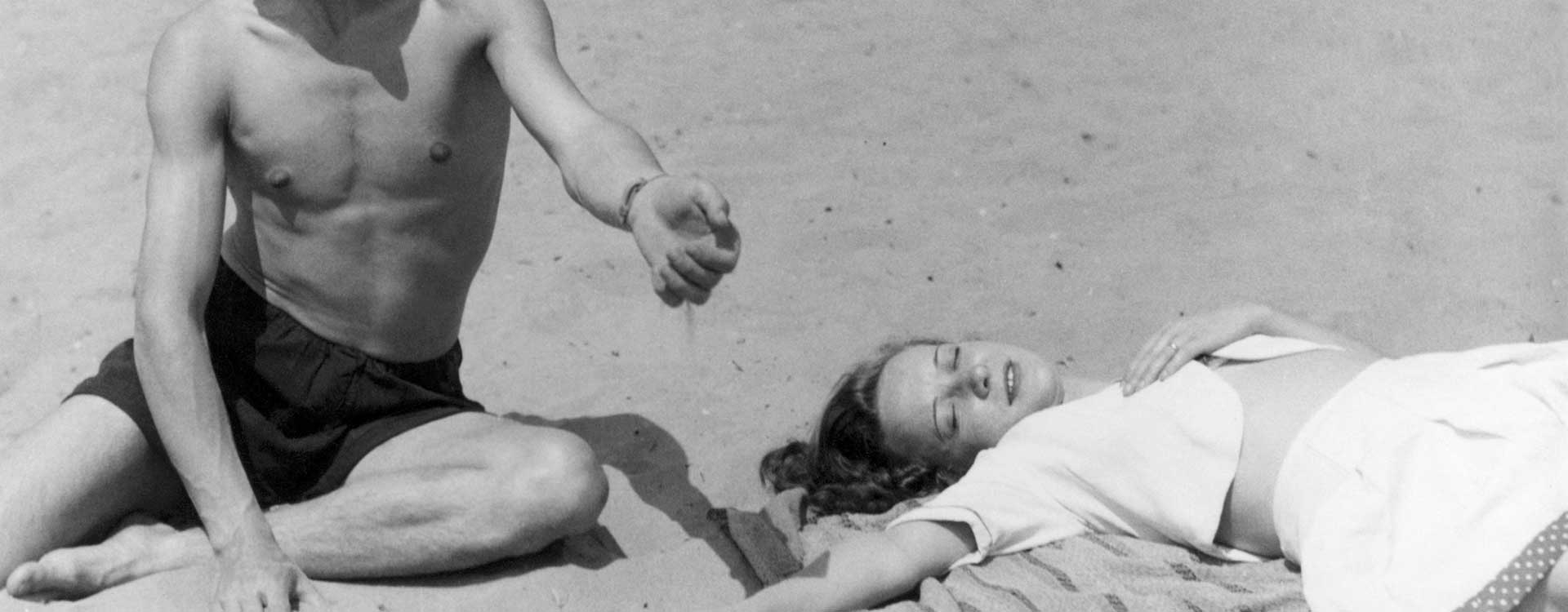Ever Tan
Long before the ozone hole even reached the size of a pinhead, Romans bathed in the light of the Thermae’s solarium. As attested by Cicero, this practice of skin coloring has complemented hygiene and personal care since Antiquity. This “sun shower” was enjoyed on dry or oiled skin, and its continued use has been confirmed in subsequent centuries, whether at the Thermae for men (mostly) or at home for women: it has been reported that in the 3rd century A.D., Cornelia, Emperor Gallienus’s wife, was an enthusiastic practitioner of the sunbath. Back then, elegant Roman women used to try and turn their hair blond by exposing it to the sun’s intense rays, spread on wide bottomless straw hats… On the other side of the Mediterranean, in Ra’s empire, around 1350 B.C., Pharaoh Akhenaten worshipped the sun to such an extent that this exclusive passion led him to favor open-air courtyards for his palaces and temples, so that nothing should stand in the way of the divine brightness. Still, Egyptian recipes for fards destined to lighten the complexion are numerous: alabaster powder, donkey milk, Ibis droppings… These complicated recipes were meant to even the skin tone and bring it closer to the light. As elsewhere, a tan was a sign of virility, whereas fairer carnations were tokens of femininity. Frescoes and the painted statues of couples found in tombs testify to this canonical difference in terms of complexions: a dark, copper-like ochre for boys and a light, yellow ochre for girls. Greek women, who were veiled in public settings, just like Egyptian women before them and their Roman counterparts later on, were supposed to preserve as much as feasible the relative whiteness of their skin, as befitted women who lived inside. In the Iliad, set in the 13th century B.C., Homer praises Hera’s beauty by calling her the “White-Armed Goddess”, which also under lines her virtue and incidentally allows the poet to land on his metrical feet. In the 4th century B.C., the father of medicine, Hippocrates, recommended solar therapy to combat certain afflictions, as did Avicenna – the 11th-century Persian doctor and philosopher – who, however, already warned against the ill-effects of excessive exposure. In the animated picture The Sword in the Stone, after a memorable battle of magic spells against Madam Mim, Merlin performs a good deed: using his staff, he pierces the thatch roof of the little cottage in which the defeated witch is bedridden, letting the sunshine splash onto her pustulous face. Through tanning, she will thus heal faster from the magi-microbe that has just infected her – sufficient proof that heliotherapy (if not “suntan”) has long infiltrated the collective subconscious.
After a few centuries’ eclipse in the West, the healing sun reappeared at the time of the Enlightenment. It is in Eastern Europe and in Germany that sun exposure once again became therapeutically recommended. Sunray cures, combined with the open air, were reputed to revitalize the system, to vivify, to fortify… The germicidal, fungicidal and bactericidal properties of the sun had been surmised since the 17th century; they were demonstrated and put in practice in the 19th. In England, the first beach resorts opened in the 1760s, mostly so people could take in the sea air on sunny days. In Europe, over the next century, coasts and mountains witnessed the blossoming of health spas – first among which the sanatoriums, where naturist temptations first appeared, along with various forms of alternative medicine for experimental doktors and miscellaneous Germanic gurus. In such places, the sun was imbibed in massive doses. Doctors first tried their hands on the tuberculous, the rachitic, the lungy, on all kinds of itches… Then, little by little, some of these resorts opened their doors to vacationers. The jet set did not yet fly but instead rolled up to the beneficent sunrays in Pullman cars. One would have to wait until the end of the century before the “sunbathing” phenomenon crystallized in one symbolic place, the epitome of the coastal resort area: Stephen Liegeard struck gold in 1887 when he coined its name, La Côte d’azur – ‘The Azure Coast’, a.k.a. the French Riviera.
At the turn of the century, even though the sun was again considered health’s faithful ally, it was not yet deemed beauty’s best friend. Elegant society women and those of the demi-monde still went about modestly sheltered by their parasols. One did bathe, but in full costume. After nightfall, under their lace frillings, their beaus still looked for the forbidden – erotic! – pallor of the sugar-colored flesh. It’s a long story. Throughout the Middle Ages, in the West, the body was seen as the dominion of sin. To remain pure, the body’s page must remain blank. There lies a strange paradox, reminiscent of Aten’s Egypt: although brightness and light are Christian symbols, a perpetual theophany, the skin must be shielded from them and prove through its pallor that intimacy had not been exposed to the sun, and therefore metaphorically to the gaze of others. The whiter the lady, the more virtuous; the more virtuous, the more worthy of her “blood”, and therefore the more coveted. Only the peasant girl, the maid or the untouchable, compelled to work on the land, at somebody’s service or outdoors, wore the mark of the sun. This tan – contemptuously termed a “haggard” or “yellow” complexion – was the token of her class. In the terrifying paintings by Hieronymus Bosch, the skin tone of the devils and their henchmen is bronzed and yellowed by hell’s inverted suns… In the poetry of courtly love, the whiteness of the neck – swanlike – and the pallor of the forehead – alabaster – are sung, and this distinction based on color endured throughout the Renaissance, whether in the complexion of the Venuses of sacred love or on the forehead of the Madonnas. In the late 16th century, in his Lives of the Gallant Ladies, Brantôme wrote that three things must be white: “the skin, the teeth, and the hands”. That says it all, and it would remain so until the 20th century. Until then, the belles would poison themselves with Venetian Ceruse (known and used since Antiquity), a.k.a. Spirits of Saturn, a lead-based cosmetic paste that whitens the skin but causes severe intoxications. In the late 18th century, medical advances were to prove the noxious effects of this substance, which gradually fell out of use, along with the other symbols of the Ancien Régime.
Thanks to liberal doses of rice powder, diaphanous and romantic complexions would remain in fashion for another whole century, until the livid exaggeration inspired by Gothic novels.
However, things were evolving subterraneously, and heliotropism was brewing in the second half of the century. Society itself was on the brink of an unprecedented turnaround. The working classes no longer worked in the fields, but in the factories or mines, and pale skin tones soon became associated with the commoners. Conversely, the upper classes were revising their standards, while successive conflicts – particularly the First World War – were changing the place of women place in society and gradually putting them out in the open. It is through women and sports that the “suntan” made its entrance into the fashionable set. This supposedly resulted from Gabrielle Chanel’s self-confidence. It is said that in Deauville, in the summer of 1918 – or was it 1923, or perhaps 1925? –, Chanel, a devotee of horseback riding nd of the great outdoors who had already done away with the corset, got “sunburned”. The “bronzed” look was born. “The invention of the suntan” is in fact more complex than that, as Pascal Ory demonstrates in his eponymous study, L’invention du bronzage. It was spurred by the liberation of the female body and the transformation of the female wardrobe, by the scar left by the pallid specters of the trench wars, by the advent of a new society in which castes were split open and where technological progress made other suns available, and the sun available to all. On the Côte d’azur, the Noailles Villa was the precious and cerebral archetype of this trend.
The new rationalist architectures now welcomed the sun on roofs, terraces and swimming pools, as a coat of modernity.
For others, the rise of paid annual leave tinted blue collar faces a joyous brown. Until then, skin darkened; from then on, it tanned. As if, through a mere choice of words, skin color had become a suit of armor and the body a new piece of work, at a time between the 1920s and 40s when “modern man” was being built – a time of nostalgia for Antiquity, for the empires and their brazen bodies. Hygienist, modernist, machine-like, modern man was in motion, sometimes at a military pace, “Sol Invictus” down to the fires of hell.
The darkening of the skin results from the cutaneous reaction to sunlight and its ultraviolet component. The epidermis “defends” itself by producing melanin, a pigment which helps protect the body from the absorption of these rays. Its benefits and ill-effects are now understood and the beauty industry has long since followed in the footsteps of outdoor sports and of the Café society’s leisure activities. In 1924, Jean Patou opened a pair of swimsuit stores in Deauville and Biarritz. In 1927, he launched his Huile de Chaldée, the first suntan oil, reputed to prepare the epidermis to exposure. By the early 1930s, the products promising better bronzing had replaced whitening formulations. Sunbathing became ubiquitous, from the shores to the summits (such as Piz Buin, a mountain peak separating Austria from Switzerland, where the famous sun cream of the same name was invented). At the close of World War II, the mood was festive. It was urgent to live. Hope dreamed of happiness, of a perpetual summer; man dreamed of “vacations” – no longer mere “leaves”, but actual interludes of open-air freedom. The two-piece bathing suit already existed before the war, yet it made its real splash in 1946 with the Bikini. The suntan thus found its most beguiling assistant, and extended its domain “sous le soleil exactement” – “under the sun precisely” –, as the Gainsbourg song would later put it. Skin coloring was now erotic and the body on display everywhere you looked. From then on, the swimsuit would be a mere cache-sexe; it shrank down to its barest essentials, down to the monokini, invented in 1964 but really popularized in the 1980s. Oils, creams, milks… a veritable cosmetic arsenal was born out of a new obsession: getting a tan – fast! Accelerating and protective lotions, dietary supplements… getting a tan – properly! Protection factors, restorative skin care, optimal solar safety… A tan can now even do without the sun entirely: the first tanning beds were invented in 1975; self-tanning products color the skin with no exposure whatsoever.
All the while, the ozone hole had morphed into a sidereal chasm. But was it real or fake? Either way, when eyes were first set on it, it allegedly covered much of Australia… Once symbolic of emancipation, of an active lifestyle, of a communion with nature, but also of modernity, the suntan suddenly became suspicious, tinged with obsolescence – a sign of degeneration, self-abuse and shameful passivity.
Stéphanie Hussonnois-Bouhayati








laissez un commentaire
Connectez-vous pour poster des commentaires